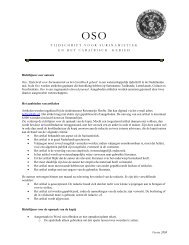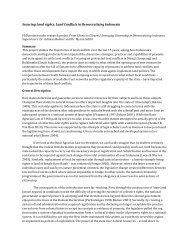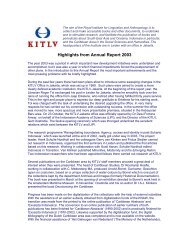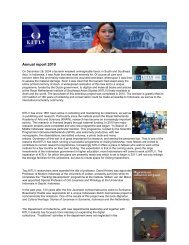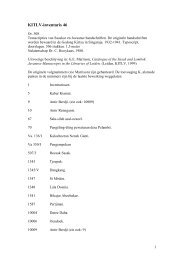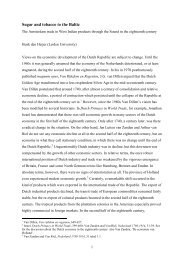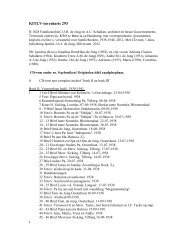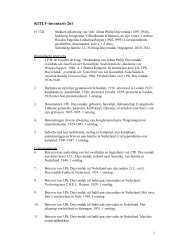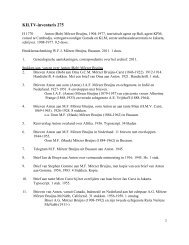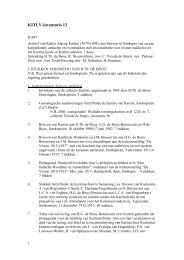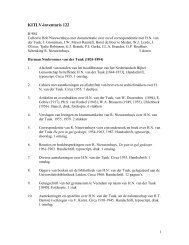The Acehnese past and its present state of study R. Michael ... - kitlv
The Acehnese past and its present state of study R. Michael ... - kitlv
The Acehnese past and its present state of study R. Michael ... - kitlv
You also want an ePaper? Increase the reach of your titles
YUMPU automatically turns print PDFs into web optimized ePapers that Google loves.
Aceh as a fi eld for ancient history studies 33<br />
additional details are given. This chronicle is remarkable because certainly,<br />
without knowing about the existence <strong>of</strong> the ancient settlement <strong>of</strong> Lobu Tua,<br />
<strong>and</strong> knowing even less about the existence <strong>of</strong> the Tamil inscription, it recounts<br />
that Barus was founded by Chetti <strong>and</strong> Hindus (Drakard 2003:142). As such,<br />
the chronicle preserves in the collective memory a 1,000-year-old event now<br />
confi rmed by archaeology.<br />
<strong>The</strong> account <strong>of</strong> the successive foundations <strong>of</strong> settlements in the Barus area<br />
in the same chronicle leads us to the site <strong>of</strong> Bukit Hasang. From a physical<br />
perspective, this site is very similar to Lobu Tua. It overlooks the coast at<br />
an altitude <strong>of</strong> about 20 m, <strong>and</strong> includes a fortifi ed central area estimated at<br />
some 15 ha, if we take into account the erosion processes that have ‘eaten<br />
away’ one <strong>of</strong> <strong>its</strong> sides (Perret <strong>and</strong> Surachman, 2009). Nearly 700 m² were<br />
excavated on this site. Among the artefacts found are more than 43,000 shards<br />
<strong>of</strong> imported ceramics <strong>and</strong> more than 120,000 shards <strong>of</strong> pottery exceeding a ton<br />
in weight. Although the analysis <strong>of</strong> these artefacts has yet to be completed,<br />
we can already suggest that the site was founded by the mid-twelfth century<br />
<strong>and</strong> reached <strong>its</strong> peak between the mid-thirteenth century <strong>and</strong> the turn <strong>of</strong> the<br />
fi fteenth century. Deserted during most <strong>of</strong> the fi fteenth century, it was resettled<br />
again between the end <strong>of</strong> the fi fteenth century <strong>and</strong> the mid-sixteenth<br />
century over a wider area, probably between 45 <strong>and</strong> 65 ha. <strong>The</strong> proportion <strong>of</strong><br />
imported pottery seems much less signifi cant than at Lobu Tua, suggesting a<br />
more homogeneous population.<br />
<strong>The</strong> inscription on one <strong>of</strong> the oldest dated tombstones found on the site<br />
(1370) gives an idea <strong>of</strong> the complexity <strong>of</strong> this society. It contains Arabic words<br />
using Persian grammar, a Malay word, a name that could be Chinese, as well<br />
as a formula attested in Turkey <strong>and</strong> Yemen (Kalus 2003:305-6).<br />
Other connections between Barus <strong>and</strong> the Middle East are documented<br />
with the recent rediscovery, by Ludvik Kalus <strong>and</strong> Claude Guillot, <strong>of</strong> the epitaph<br />
<strong>of</strong> Hamza Fansuri. This early Malay sufi poet’s name, ‘Fansuri’, indicates a<br />
strong relation with Barus (Kalus <strong>and</strong> Guillot 2000, 2007). <strong>The</strong> inscription on<br />
his gravestone was recorded in 1934 by an Egyptian epigraphist at a cemetery<br />
in Mecca, dating the death <strong>of</strong> Shaykh Hamza b. Abd Allah al-Fansuri to 933<br />
H/1527 CE – well before the date generally assumed. It is thus possible to<br />
suggest that Hamza Fansuri may have lived in Bukit Hasang at some point<br />
before moving to Mecca. Apart from the implications <strong>of</strong> this rediscovery for<br />
the history <strong>of</strong> the poet himself, it is now clear that he probably never lived in<br />
Aceh proper, which was just emerging as a trading centre <strong>and</strong> Muslim polity<br />
at that time. Based on this rediscovery, it can be suggested that Barus was<br />
perhaps an important centre for Malay literature during this period. Barus<br />
was certainly strongly infl uenced by Aceh later, as seen in the <strong>Acehnese</strong><br />
tombstones brought there <strong>and</strong> in the Aceh-infl uenced monuments made there<br />
between the sixteenth century <strong>and</strong> the turn <strong>of</strong> the twentieth century. Directly




